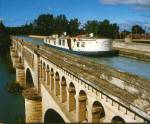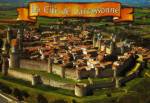Bezier is near the start of the 240 km/ 150 mile Canal du Midi. This colossal engineering achievement enabled bulk cargo to be moved from the Mediterranean to Toulouse and down the Garonne River to Bordeaux on the Atlantic, bypassing the long journey around Spain and Portugal. As Collector of the Salt Tax for Languedoc, Pierre-Paul Riquet amassed a considerable fortune but sank it all into achieving his vision. However, the costs were so great that he had to seek government funds as well. He died just before it was completed in 1681.Note 1
An incredible massacre took place in Bezier in 1209 as part of the Albigensian CrusadeNote 2. You have probably heard of the crusades against the Muslims in the Holy Land and Spain but this was against fellow-Christians.
The Cathars renounced worldly pleasures believing they came from the Devil and lived an austere, simple life. There were similarities with the movement started slightly later by St. Francis of Assisi. However, they opposed the teachings and authority of the Roman Catholic church.. Politically, the Languedoc region where the sect was strongest was outside the control of the French king. The Pope organized a Crusade to rid the region of heretics promising the soldiers an indulgence (forgiveness of their sins) and allowing the French knights to confiscate the lands the conquered.
When the Crusaders arrived in Bezier on 21st July, they demanded that the Cathars be handed over but the local Roman Catholics did not co-operate. On the 22nd, the invaders broke through the town walls and started killing everyone. When asked by one of the crusaders about the possible killing of Catholics along with the heretic Cathars, the Papal representative is supposed to have replied "Kill them all! God will recognize His own!" Between 10,000 and 20,000 died that day, including 6,000 that had sought refuge on church grounds. The Crusade continued on and off until 1255.
Carcassonne is Europe’s quintessential fortified city. The defenses reached their current form in the 13th Century: two massive walls with imposing towers shield a large castle within. However, in the 17th Century, the border with Spain moved south making the fortifications redundant.
Legend has it that during a long siege by Charlemagne in the 9th Century, the city was starving and close to surrender. The mayoress had an idea: a pig was fed with the last of the grain and catapulted over the wall. The animal burst on impact, scattering the grain. The attackers concluded that they city must still have plenty of food—so they gave up the siege and went home!
We visited several small medieval towns including pretty Sarlat which is now home to the fois gras (goose liver paste) industry. I wasn't keen on the product anyway but I now see that the geese are force-fed, I'm even less interested.
After visiting the famous chateaux of the Loire River valley around Tours and Blois in 1983, I could see why the French had a revolution. If I were a peasant toiling in the fields, I'd consider cutting off the heads of those who erected such vulgar displays of wealth. Nevertheless, they are nice to look at, none more so that Chenonceau.
Built in the 16th Century, its architecture reflected the new political stability as its features were for decoration rather than defense. It escaped the Revolution largely unscathed as the owners had been generous to the local people so they were spared, as were the remarkable furniture and tapestries.
We also saw Villandry or at least its beautiful gardens, Azay-le-Rideau that sits in a lake by a river, the outside of Ulssé and mighty Chambord.
At this point I should comment on eating in France. Since we were on secondary roads most of the time, our first stop of the day was generally at a village patisserie/boulangerie (bakery) to get something for breakfast and to take something away for lunch. I can now say with some authority that the best in all of France was in le Bourgneuf-la Forét, a mere speck on the map. After a few mouthfuls of a chocolatey/almondy thing, Lan went back in for more!
Sadly, it appears that village life in France is dying, just as it is in small towns across America and Australia. Most of the young people have moved to the big cities with their suburban shopping malls and tract homes making them look like everywhere else. The most picturesque villages will remain as tourist attractions but they will lose, if they haven't already, their workaday authenticity.
I got tired of French drivers that constantly tailgated me, even if I was 20km/h over the speed limit. If I came to a roundabout, I generally went around several times to let them pass. Not long after leaving le Bourgneuf-la Forét we thought we were about to witness a fatal collision. We were driving along at the 90 km/h limit on a road over rolling hills. Someone came up behind doing at least 120 and then swung out to overtake only to find an oncoming car approaching over the crest of the hill. He was able to slam on the brakes and get back behind us but after that he stayed well back and matched our speed. It seemed that the incident had scared the merde out of him.
Mont St. Michel rises above the mudflats on a granite outcrop just offshore like a huge ship at sea. The first Christian building on the site was built in 708 and it gradually grew from there along with fortifications and a village at the bottom of the slopes. In fact, the statue of St Michael on top of the steep is a mere century old. After the Revolution, it was used as a prison for a time. The car park is flooded during very high tides so a sign tells you in French, English and German how long you can stay.







